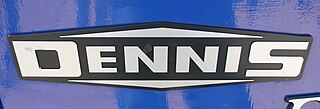
Dennis Specialist Vehicles was an English manufacturer of commercial vehicles based in Guildford, building buses, fire engines, lorries (trucks) and municipal vehicles such as dustcarts. All vehicles were made to order to the customer's requirements and more strongly built than mass production equivalents. For most of the 20th century the Dennis company was Guildford's main employer.

The Volvo B9TL is a low-floor double-decker bus built by Volvo from 2002 until 2018. It superseded the Volvo Super Olympian and the Volvo B7TL. The 2-axle version has been superseded by the Volvo B5TL in 2014 and the 3-axle version has been superseded by the Volvo B8L in 2018.

The Scania N113 was a transverse-engined step-entrance and low-floor city bus chassis manufactured by Scania between 1988 and 2000.

The Dennis Dart is a rear-engined single-decker midibus chassis that was introduced by Dennis Specialist Vehicles of Guildford, England in 1989, replacing the Dennis Domino. Initially built as a high-floor design, In 1996 the low-floor second generation Dennis Dart SLF was launched. In 2001, production of the Dart SLF passed to TransBus International, during which time it was sold as the TransBus Dart SLF; Alexander Dennis took over production in 2004, renaming the product as the Alexander Dennis Dart SLF.

The Dennis Dominator was Dennis's first rear-engined double-decker bus chassis, it was launched in 1977.

The Scania N112 was a transversely-engined step-entrance single-decker bus, double-decker bus and articulated bus chassis manufactured by Scania between 1978 and 1987.

The Ford R series was a range of single-decker bus and single-decker coach chassis, built by Ford that evolved from designs made by Thames Trader until the mid-1960s. A number of components were shared with the D-series lorry, including the engine which was mounted vertically at the front of the vehicle, ahead of the front axle so as to provide a passenger entrance opposite the driver. The original R192 and longer R226 models later became the R1014 and R1114 variants which with constant revision and upgrading had become R1015 and R1115 by the mid-1980s. In an attempt to lower the floor height of the vehicle, the turbocharged diesel engine was tilted over to one side around 1978. Synchromesh transmission was fitted as standard but some later examples were equipped with Allison automatic gearboxes to ease the driver's workload in urban areas. It ceased production in 1985.

Duple Coachbuilders was a coach and bus bodybuilder in England from 1919 until 1989.

Dennis Trident 3, is the first low floor tri-axle double-decker bus chassis built by Dennis in the United Kingdom, with a large number purchased by bus companies in Hong Kong, Singapore, the United States and Canada.

The Volvo Ailsa B55 was a front-engined double-decker bus chassis manufactured in Scotland by Ailsa, Volvo's British subsidiary in which it owned 75%, from 1974 until 1985.

Duple Metsec was a bus bodywork builder based in West Midlands of England in the United Kingdom. It usually supplied body kits for bus assembly overseas.

The Volvo B10M was a mid-engined city bus and coach chassis manufactured by Volvo between 1978 and 2003. It succeeded the B58 and was equipped with the same 9.6-litre horizontally mounted Volvo diesel engine mounted under the floor behind the front axle. An articulated version under the model name Volvo B10MA was also offered, as was a semi-integral version known as the C10M, with the engine in the middle of the chassis.

The Dennis Jubilant was a front engined double decker bus chassis manufactured by Dennis between 1977 and 1981. It was specifically designed for contemporary operating environment in Hong Kong.

The Dennis Dragon was a three-axle step-entrance double-decker bus manufactured by Dennis in England between 1982 and 1999.

The Leyland Victory Mark 2 is a front-engined double-decker bus chassis manufactured by Leyland between 1978 and 1981. Like its competitor the Dennis Jubilant it was specifically designed for the contemporary operating environment in Hong Kong.

The Dennis Lance was a single-decker bus chassis manufactured by Dennis between 1991 and 2000, replacing the Dennis Falcon. Its low floor variant, the Dennis Lance SLF was built between 1993 and 1996. Between 1995 and 1998, Dennis also built its double-deck variant, the Dennis Arrow, as the replacement of the Dennis Dominator.

Barton Transport was a bus company that operated in Nottinghamshire from 1908 until 1989.

The Daimler Fleetline is a rear-engined double-decker bus chassis which was built between 1960 and 1983.
The Dennis Dorchester was a mid-engined heavy-duty single deck coach or bus chassis manufactured by Dennis in small numbers between 1983 and 1988.

The Daimler Freeline was an underfloor-engined bus chassis built by Daimler between 1951 and 1964. It was a very poor seller in the UK market for an underfloor-engined bus and coach chassis, but became a substantial export success.





















